Pagasa expects ‘smaze’ to abate soon
THE STATE weather bureau on Monday said the smaze (combination of smoke and haze) shrouding the Visayas and Mindanao should abate soon because the winds from the forest fires in Indonesia had shifted direction.
The Philippine Atmospheric, Geophysical and Astronomical Services Administration (Pagasa) however said some of the smoke that may have accumulated over the Pacific Ocean from weeks of forest fires may still be blowing toward the country instead.
“We don’t expect that it will spread wider. Our expectation is that the smaze will gradually disperse,” said chief climatologist Anthony Lucero.
According to the wind analysis provided in the Singapore-based haze monitoring center, the wind blowing into the country was now coming from the east, or from the Pacific Ocean, and not from the equatorial region where Indonesia is located, he said.
“The wind that is blowing the smaze here is gone. In my opinion, the smaze should begin to clear out,” Lucero said.
Article continues after this advertisement“But if there is still smaze, it may be from the smoke that is coming from the Pacific,” he added.
Article continues after this advertisementThe forest fires have been raging for about two months now and some of the smoke that has engulfed Indonesia and neighboring countries may have drifted over the Pacific.
“So it’s possible we can still observe smaze. But it’s not as dense as before since it’s no longer coming from the source,” Lucero said.
Smaze vs smog
He explained why Pagasa used the term smaze as against smog (combination of smoke and fog).
Fog is more dense than haze, he said, although both refer to the natural occurrence of water droplets suspended in the air in the early morning that evaporate in the daytime.
When smoke and air pollutants mix with the fog and haze, the resulting combination becomes a public hazard.
In many areas in the Visayas and Mindanao, flights have been canceled due to poor visibility and people have been advised to wear masks and stay indoors due to the heightened risk of respiratory ailments.
While reports of unusual haze have come in last month, Pagasa acknowledged the problem only last week.
In a statement on Oct. 23, Pagasa said the thick smaze observed over Mindanao and the Palawan-Visayas islands came from the peatland forest fires in Indonesia.
It said wind analysis suggested that the smaze drifted over because equatorial winds enhanced by Typhoon “Lando” (international name: Koppu) had reached the Philippines.
